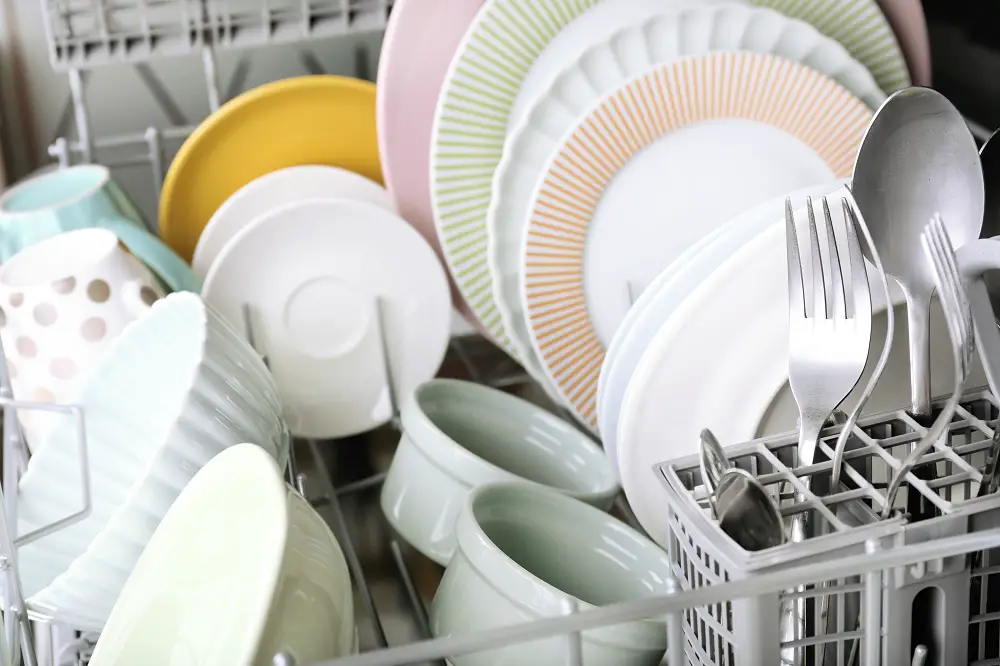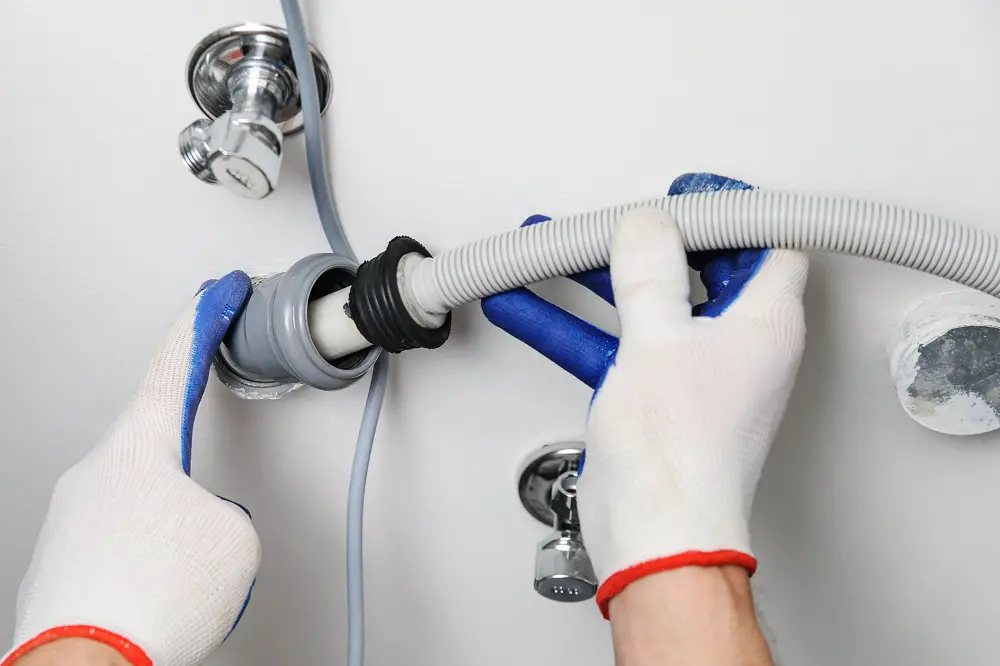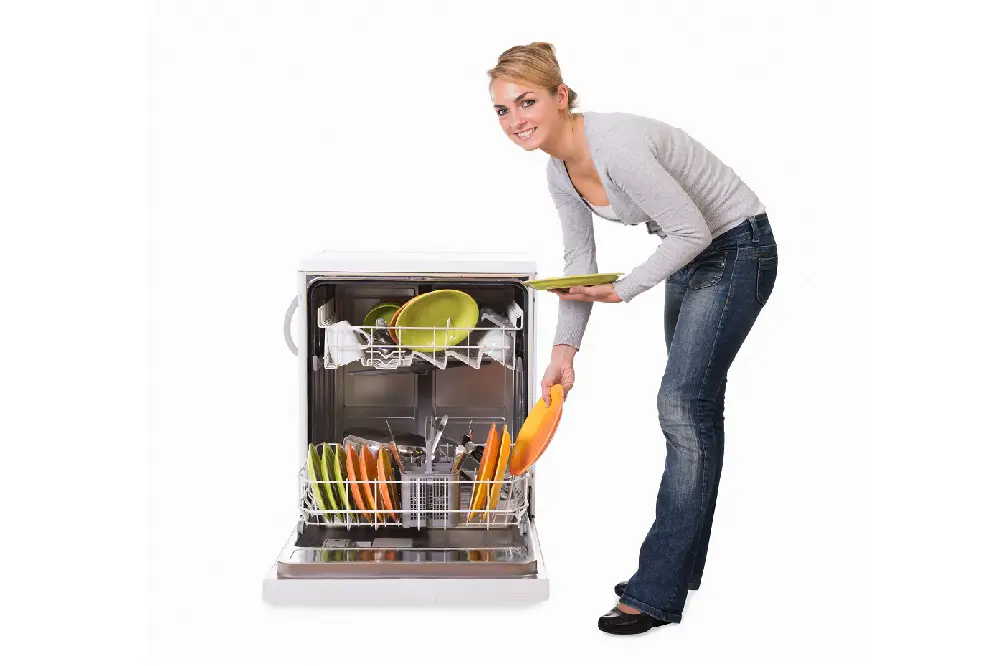Countertop dishwashers are the lesser-known yet, convenient solution to clean a relatively small load of dishes and vessels.
With a compact size, they’re designed to fit easily on your kitchen counter. But how do countertop dishwashers work?
While countertop dishwashers differ from a freestanding or built-in model in some ways, generally, they all operate similarly. It draws water from the sink faucet, the motor circulates the water through the spray arms, and the drain cycle expels water through a drain hose.

Let’s look into the details of how countertop dishwashers work.
Table of Contents
Working Principle of Countertop Dishwashers
Understanding the working principle of countertop dishwashers is helpful in diagnosing any issues and making the necessary fixes by yourself.
The countertop dishwashers (except for models with a built-in water tank) must be connected to the kitchen faucet for water supply. They use electricity to power the motor that drives the washing cycle.
Here’s what the working principle of countertop dishwashers looks like:
- Water Intake
Once you’ve loaded the dishes and detergent, closed the door, and selected the wash cycle, the water inlet valve opens, allowing water to enter the dishwasher.
The dishwasher’s float switch detects the water level and causes the water valve to close once the water has reached the desired level.
- Heating Element
The hotter the water temperature, the better the dishwasher’s performance. Hot water works well in dissolving grease and stubborn residues on the dishes.
Most modern dishwashers have a heating element that heats the water to the appropriate temperature, typically between 120o-160oF.
Find out more about the water temperature of a portable dishwasher in our guide
- Detergent Dispensing
A countertop dishwasher model has a compartment for adding detergent, just like regular dishwashers. At an appropriate stage of the wash cycle, the detergent is automatically released into the dishwasher, along with the water.
- Wash Cycle
The dishwasher’s motor powers the rotating spray arms and circulates water (which helps distribute the detergent) evenly over the dishes. The spray arms use high-pressure jets to spray water, which removes stubborn stains and debris from the dishes.
Any leftover debris is collected in the dishwasher filter.
- Drain Cycle
After the completion of the wash cycle, the dirty water is drained from the dishwasher. The drain pump facilitates the drainage of the water through the drain hose into the sink.
Draining isn’t as easy as it may appear – read our complete answer on how portable dishwashers drain.
Following this, the rinse cycle begins. During this cycle, the dishwasher dispenses rinse aid (if you have loaded it), which will help your dishes dry faster and avoid hard water-caused spots.
Finally, the dishwasher goes through another drain cycle that will remove the remaining water, after which the drying process begins.
Installation of Countertop Dishwashers
Unlike built-in models that require permanent modifications to your kitchen, the installation process of countertop dishwashers is pretty straightforward.
Here are the steps involved in the installation of countertop models:
- Place the dishwasher
on your kitchen counter. It’s recommended to position it near the sink while ensuring enough space to open the door for loading/unloading. - Hook up the water supply
by connecting the water inlet hose to the kitchen faucet. Remove the faucet aerator before doing so, and use a suitable adapter to connect the hose. - Position the drain hose
to drain water into the sink. Consider using a suction clamp to mount the drain hose in the sink securely. - Open the sink faucet
after securing all the connections between the dishwasher and the kitchen sink. Check for leaks between the dishwasher inlet port and faucet, and accordingly fix any leaks. - Load your dishwasher
and plug the machine into a nearby electrical outlet. - Load the detergent and run a wash cycle.
Here’s a detailed guide on How to Hook up a Countertop Dishwasher. It’ll only take a few minutes to get things started.
Advantages of Countertop Dishwashers
If you’re deciding on whether to purchase a countertop dishwasher (here are our best small portables) or not, here are the advantages these compact appliances offer, making them an attractive option:
- Portability:
Countertop dishwashers are lightweight and can be moved around easily. This makes it convenient to take your dishwasher with you if renting a space or shifting homes. - Space-Saving Design:
With a compact design, countertop dishwashers are ideal for small kitchens or apartments with limited floor space. - Sustainable:
Owing to their small size, countertop dishwashers use less energy and water per cycle when compared to built-in or free-standing models. - Cost-Effective:
Countertop models are generally more affordable than their larger counterparts. This makes it an excellent option if you’re on a tight budget and don’t want to invest in a larger machine.
Differences From a Freestanding and Regular Model
While countertop dishwashers are similar to freestanding and regular models in several aspects, there are some key differences to consider:
| Features | Countertop | Freestanding | Regular |
|---|---|---|---|
| Installation | Not required. Sits on the kitchen counter. | Not required. It is on wheels. | Permanent installation required. |
| Portability | Lightweight; Easy to move around | Can be rolled away | Not portable |
| Dimensions (WxHxD) | 22”x17”x20” | 24”x37”x27” | 30-42”x35”x24” |
| Water Usage | ~ 2 gallons | ~ 3 gallons | 3-4 gallons |
| Place Settings | 4-8 | 6-14 | 10-14 |
| Electricity Usage | 1-1.5 kWh | 1-2 kWh | 1-2 kWh |
Conclusion
Countertop dishwashers are a convenient and space-efficient solution for smaller households and kitchens. They operate similarly to regular and freestanding models. However, they offer greater mobility and are more cost-effective.
With a straightforward installation process, countertop dishwashers can be conveniently placed on your kitchen counter next to the sink.
Some advantages of countertop models, when compared to freestanding or built-in dishwashers, are water and energy efficiency, compact size, and increased portability.
If you accumulate only a small load of dishes and would like to save time and effort on handwashing dishes, a countertop dishwasher will make an excellent addition to your kitchen setup.




I definitely appreciate the installation part. Got my countertop dishwasher last year and it was a breeze to set up. Didn’t need to make any permanent changes to my kitchen, which is great since I’m renting. Saves water too, which is a bonus for someone trying to live a bit more sustainably.
does anyone know if these small dishwashers can handle the kinda mess a pizza night with the roomies can make? we’re thinking of chipping in for one.
Yep, works fine for me after game nights. Just scrape off the big bits first!
but does it get the cheese off?
Wow, had no idea these countertop dishwashers were so handy! Definitely considering getting one now, especially since it seems like they’re good on space and easy to install. Perfect for my small apartment. Thanks for the info, Martin!
Interesting article, Martin. I’m curious about the energy efficiency of these models compared to their larger counterparts. Do countertop dishwashers use significantly less electricity? It would be a key selling point for me.
are these complicated to use? not very good with tech gadgets.
The segment on the advantages perfectly captured why a countertop dishwasher appeals to me. as someone who cherishes simplicity, the functional yet uncomplicated nature of these devices is exactly what I’ve been looking for.
Can anyone compare the water usage of countertop vs regular dishwashers?
I’ve had both types of dishwashers and I must say, the countertop one fits my lifestyle perfectly. I cook a lot but hate the cleanup. This little gadget has been a lifesaver!
Does anyone know if there’s a model that’s particularly quiet? My apartment is tiny and I don’t want it to drown out everything else when it runs.
For those worried about installing a countertop dishwasher, don’t be! I’m not a plumbing expert but I managed to install mine by following the manual closely. Make sure you’ve got the right adapter for your tap and double-check all connections for leaks. A little bit of effort goes a long way in making your kitchen more functional.